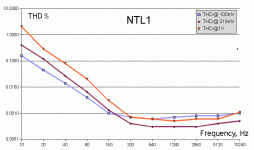Good input, Dimitri. I didn't know that transformers were made a certain way to sound phat, but many are. Especially musical instrument transformers. Please read AN 104 also.
Exactly that I have done in a "bass warmifier" pedal (for electric bass guitar), with the cheapest xformer I could find, some $2 or so Xicon.Originally posted by Steve Eddy
I'd had some thoughts of using a little M6 Edcor or similar for a tube-less guitar distortion unit. It would use a level adjustment to gradually overload the transformer, as well as having an adjustable DC current that could be run through one of the windings to make the distortion more asymmetric.
Essentially the same trick with guitar amp OPTs in well balanced amps (not many, that is) which sligthly distort only the bass/fundamentals but leaving the rest of the spectrum (more or less) untouched -- and some vintage microphones do just the same to get their warm sound in the bass...
In guitar amps, depending on phase splitter type and PSU sag some DC imbalance happens all the time, resulting in a rich tone with a constantly changing character... I'm sort of digressing here... but IMO and IME instrument amplifier design is at least equally difficult as HighEnd audio gear... control all the parasitics and make them work for you...
- Klaus
This spectrum is really ugly.
Look on the perfect decay of harmonics with harmonic order (Hiraga wrote that is magrinal), and the 7-th is -130dB only - that is very good - right, John?
john curl said:Good enough for Rock and Roll!
My compliments to John Curl, a real combatant designer.
Fotios
Somehow I think that the low level THD tests are really THD plus noise reading. Most of readily available test equipment a few decades ago was not nearly as sophisticated as current test sets.
KSTR said:Exactly that I have done in a "bass warmifier" pedal (for electric bass guitar), with the cheapest xformer I could find, some $2 or so Xicon.
Essentially the same trick with guitar amp OPTs in well balanced amps (not many, that is) which sligthly distort only the bass/fundamentals but leaving the rest of the spectrum (more or less) untouched -- and some vintage microphones do just the same to get their warm sound in the bass...
In guitar amps, depending on phase splitter type and PSU sag some DC imbalance happens all the time, resulting in a rich tone with a constantly changing character... I'm sort of digressing here... but IMO and IME instrument amplifier design is at least equally difficult as HighEnd audio gear... control all the parasitics and make them work for you...
Thanks, Klaus!
Yeah, the one thing I'm concerned about is being able to get sufficient levels of distortion at higher frequencies. I think it'd be best to go with an M6 core because if it's "fat" B-H loop. Though it would take much more to saturate it compared to a high nickel core. So maybe a really undersized core of M6 would do the trick.
se
x-pro said:FWIW, my measurements on Neutrik NTL1 line transformer, Ri=50 Ohm, Rload = 10K.
Note: THD figures below 0.001% for 100 mV output are affected by noise level of my measurement setup.
Thanks, Alex.
Tiny little thing, isn't it?
se
Yep, 18x22x12mm:Steve Eddy said:Tiny little thing, isn't it?
An externally hosted image should be here but it was not working when we last tested it.
You'd probably need a lot of HF emphasis (and deemphasis after the xf). I don't know if distortion alone from the xformer is sufficient and/or will sound any good. I've used a FET circuit and a tungsten lamp to do some additional distortion/compression (a "quick" tungsten filament lamp does some of the same "bass only" distortion thing, besides the nice compression you can get from it).Yeah, the one thing I'm concerned about is being able to get sufficient levels of distortion at higher frequencies. I think it'd be best to go with an M6 core because if it's "fat" B-H loop. Though it would take much more to saturate it compared to a high nickel core. So maybe a really undersized core of M6 would do the trick.
Undersized core seems to be a good idea, otherwise you might burn up the wire (and you, being a xformer guy, surely agree that one of the ugliest things you can have is an unidentified partial short in a winding :-/ ). My little Xicon gets pretty hot after a while...
- Klaus
dimitri said:
Look on the perfect decay of harmonics with harmonic order (Hiraga wrote that is magrinal)
Yes, like skirts of Polovtsian dances girls.
I see what you mean 😉

SIgurd
PMA said:
Yes, like skirts of Polovtsian dances girls.

SIgurd
Steve Eddy said:
Thanks, Alex.
Tiny little thing, isn't it?
se
Yes, they are very small, Klaus already posted a picture - thanks! I was expecting worse performance on LF. Here is one more graph - frequency response of NTL1 @1 V RMS on the input (THD figures were taken @1V, 316mV, 100mV RMS on the output!) and 10K load (no additional RC network)
Alex
Attachments
Looks like an SE 'dream transformer'. Small, cute, 'perfect (as all transformers are)', but how expensive?
john curl said:Looks like an SE 'dream transformer'. Small, cute, 'perfect (as all transformers are)', but how expensive?
I've paid about $140 for a pair 🙁 . Planning to use these on the input of 24-bit ADC I'm building.
Alex
- Status
- Not open for further replies.
- Home
- Amplifiers
- Solid State
- John Curl's Blowtorch preamplifier



